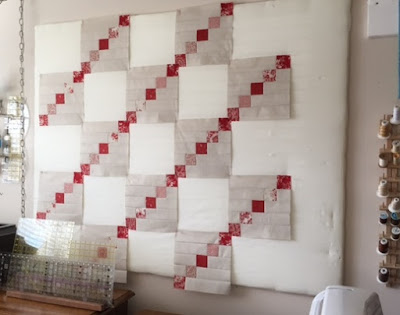 | |
|
So far, I've made six sampler blocks for Sara's Quilt. The sewing is going too fast for me to keep the patterns up to date. I'll try to get one out every week or two. Block 3 is a very basic pinwheel in a star. I loved making it because it's so quick and easy to piece.
Fabrics
Three reds, one cream, one wheat. This could be done very nicely with one light and two medium to dark fabrics of any color combination.
I forgot to photograph each fabric before cutting, and I don't have scraps of one of the reds left. This photo should help to explain the color arrangements.
Cutting and Piecing
1/4" seam allowances are used.
I like to cut any pieces used for triangles just slightly larger than needed. This way I can line seams up on the diagonal lines of my ruler and trim than back to get exact measurements and perfect points. It's so much easier to trim than to deal with pieces that are too small or a bit wonky.
Small Pinwheel
This block within a block is made with quarter square and half square triangles.
1. To make the small Pinwheel section, cut:
- one 4" square of Red 1 and one 4" square of Cream.
- two 3 1/2" squares of cream
2. Cut each square in half diagonally. Turn and cut on the other diagonal making four triangles.
3. Lay the triangles out in pairs as shown below. Make sure the positions of fabrics on all four of the pairs are the same.
3. With right sides together, sew the matching short legs of the triangles together. Press seams open.
4. Cut each 3 1/2" square of cream in half once diagonally. You will have four triangles.
6. Line the seams up with the diagonal measures on your ruler. The short seam on the half square triangles should fall exactly at the corner of the 3 inch mark. Trim each square to 3" x 3".
7. Sew the patches right sides together to make the pinwheel.
8. Press the seams open. The pinwheel block will measure 5 1/2" x 5 1/2".
Outer Star
To make the outer star, cut:
- two 3 5/8" squares of Red 2
- two 3 5/8" squares of Red 3
- four 3 5/8" squares of Wheat
- four 3" squares of Wheat
1. Draw a diagonal line on the wrong side of each 3 5/8" Wheat square.
3. Cut on the line, fold open, and press the seams open. Line the seam up with the diagonal line on your ruler and trim each half square triangle patch to 3" x 3".
4. Arrange the half square triangle patches in pairs so that the reds are in the same positions for all four pairs.
 |
| Half square triangle sections will be sewn down the center where the wheat colored pieces meet. |
6. Place one of the red and wheat sections on either side of the pinwheel block.
7. Sew 3" squares of wheat to either side of each of the red and wheat half square triangle sets. The sections will now measure 3" x 10 1/2".
8. Sew these last two sections to the top and bottom of the pinwheel block. The finished block will measure 10 1/2" x 10 1/2".
That's it. Happy Stitching!
March arrives this week! Spring is definitely on the way.

















































